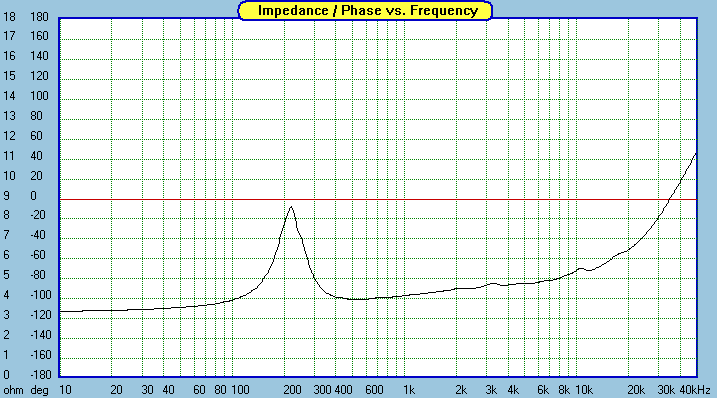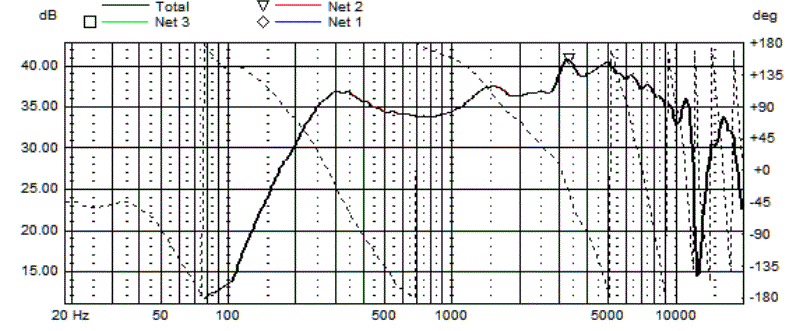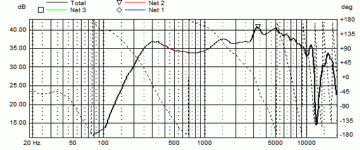As you can appreciate B&W could easily apply smoothing to their curves to lessen the impact of this peak and if they wanted they could simply photo-shop it out, it wouldn't be the first time that manufactures have done this.

True, but I unlikely see a well respected manufacturer such as B&W doing something like this and then give their prodcts away for audiotioning and technical review and especially with their very best product.
Again this are just assumptions and it might as well be just like you said.
True, but I unlikely see a well respected manufacturer such as B&W doing something like this and then give their prodcts away for audiotioning and technical review and especially with their very best product.
Again this are just assumptions and it might as well be just like you said.
Oh I agree with you, but if you look at the white paper written for the development of the 800D you will see on page 13 in the bottom right hand corner (img 14) a measurement of the FST without a crossover and it too shares the same 5dB peak at about 3.5kHz. Yet in the measurement for the driver in the cabinet with the crossover (img 12), the peak has suddenly vanished. Where did the peak go?
Now here
B&W Group North America Service & Support - Service Manuals
You can download the service manual for the 800D where it shows you the midrange drivers crossover, it's quite simple, a 2nd order electrical filter is used for both the high and low pass. This wont combat that peak in any which way, but it's suddenly vanished.
Makes sense.
Curiosity, if the midrange by B&W is one of the most linear components for these frewquency range, why would it be so bad with resonance?
B&W declares instead that the midrange was resonance free, meybe I read that wrong don't know!
Am I right or you use the same FST for your own developments?
Curiosity, if the midrange by B&W is one of the most linear components for these frewquency range, why would it be so bad with resonance?
B&W declares instead that the midrange was resonance free, meybe I read that wrong don't know!
Am I right or you use the same FST for your own developments?
No idea what spl the measurement was taken at as this doesn't really matter. Probably around 75-80dB, normal listening levels for that speaker.
If you say it's only accurate down to 1.2kHz then how come all measurement programs, that show you the accuracy cut off for the given gate length, say different? ARTA says this is accurate down to just below 300Hz providing I've set the gate accordingly, as does Holm. They ain't gonna lie about something which is presumably calculated mathematically.
Besides what makes you choose 1.2kHz?
You need to know or should know your reference voltage, industry standard is 2.83volts ..
The graph posted looks heavily smoothed and i can tell from the reflective trace to where it starts to smooth out that the software is fudging the results. I can also tell you are knowledgeable but lacking hands on , based on your comments and interp of your own data , Hence your previous comments about impulse and step responses...
I would suggest using less smoothing 5th ...
I spent many years , many moons ago , doing such sweeps, indoor treated, mic distance from floor 1m/2m/3m/ and i can tell you it does not match anechoic nor GP, GP open field , or pit firing up is best IMO, it was impossible to see any accuracy indoors below 1K unless we had a mic distance above 3M from the floor ...
Again if you wanted to know what JA would see, you had to duplicate their setup , before submission ...it's not going to look the same with , near field measurements, cutting , splicing and adding summations ...
I spent about 9 years working with Meyer's SIM2 and SIM3 measurement systems doing repair for a Broadway rental house. The truth is you can get some funky traces depending on the environment you are measuring in. The beauty of those particular system's is you have a visual indication of where the software isn't sure of the result- for SIM it's the Coherence trace. Many other pieces of measurement software do this, but SIM always seemed to perform a bit better. Then you can adjust the measurement window to suit the environment and look at your relative phase trace to get the best result trace.
What we ended up doing to have the best chance indoors was use a bunch of acoustic absorption panels. We used Sorber panels made by ClearSonics which are commonly used for vocal and drum booths for live concerts and shows. We made a sort of portable booth surrounding the SUT with 10 feet or so of panels on the floor in front of the SUT and a couple behind the measurement mic (usually a DPA 4007).
This was in early 1900's converted railway warehouses with finished plywood floors and parallel brick walls.
We found that compared to manufacturers traces done in their own anechoic chamber, we could get very close. Certainly close enough to confirm a within spec window of +/- 3 dB.
+10
Correct, wool batons and r19 thrown around the floor does help, but why bother when you can yank the damn thing outside ..
I'm sure 5th will still hang on to his "belief's" .......
Last edited:
AHAHAH!!! Woow...you guys are so knowledgable....
so my question for you wayne is: why JA was unable to match the B&W set of curves? and why does the speaker show such a coherent sound balance while looking at the curves the sound should be completely different from what you actually hear from these devices?
so my question for you wayne is: why JA was unable to match the B&W set of curves? and why does the speaker show such a coherent sound balance while looking at the curves the sound should be completely different from what you actually hear from these devices?
Sound quality of any speaker is determined by more than a flat on axis frequency response curve. Its also what kind of distortion you are sensitive to..
Myself find B&W speakers hard on the upper midrange and top end, i did not find the 801's like that , but their other modules for sure. There biggest issue with their previous versions where the small modules. Testing had shown the mid range cavity has to be pretty large to absorb reflections with out dynamic compression, our reference monitors at the time had a pretty large cavity that housed the 6 inch midrange driver .
Low and behold their revised versions (current) did have larger modules and larger drivers.
I would not read into the measurements too much , without looking at the full picture, 5th did not post up the impedance magnitude and phase , interesting to see if there were any wrinkles presentand if not for marketing most would just use paper midrange drivers , much better, very natural sounding vs Kevlar.
regards,
Myself find B&W speakers hard on the upper midrange and top end, i did not find the 801's like that , but their other modules for sure. There biggest issue with their previous versions where the small modules. Testing had shown the mid range cavity has to be pretty large to absorb reflections with out dynamic compression, our reference monitors at the time had a pretty large cavity that housed the 6 inch midrange driver .
Low and behold their revised versions (current) did have larger modules and larger drivers.
I would not read into the measurements too much , without looking at the full picture, 5th did not post up the impedance magnitude and phase , interesting to see if there were any wrinkles presentand if not for marketing most would just use paper midrange drivers , much better, very natural sounding vs Kevlar.
regards,
You need to know or should know your reference voltage, industry standard is 2.83volts ..
I don't see why knowing what exact SPL or drive level you've measured your drivers frequency response at is important. If one is using a signal that isn't so quiet as to limit the signal to noise ratio, or so loud as to have compression become an issue, then it shouldn't matter. I do make all of my distortion measurements at 2.83Vrms though.
The graph posted looks heavily smoothed and i can tell from the reflective trace to where it starts to smooth out that the software is fudging the results.
As I wrote in the previous post, there is no smoothing applied whatsoever in that measurement. That's ARTA specific unsmoothed analysis. I can show you what it looks like with smoothing if you wish, but I don't really see what the point of that would be.
I'm sure 5th will still hang on to his "belief's" .......
Well if I am wrong, then so are a lot of other people out there and who's designs must all be inaccurate and plagued with problems due to poor measurements. They aren't, though. Maybe things have changed.
Zaph did write this on his website though regarding the topic and I think it's quite relevant.
Going off on a slight tangent, I'll mention that I've heard several industry professionals say that it is impossible to obtain accurate measurements in a home environment. This is flat out wrong, and shows the closed mindedness of some people. That's almost like me saying "I don't know how to rollerskate, therefore rollerskating is impossible." There are workarounds and methodologies that may not be known (or ever needed) by someone who has an anechoic chamber at their immediate disposal. Someday when I get some time, I'll write a page on the subject.
From my point of view I guess we will just have to agree to disagree on this.
Last edited:
5th did not post up the impedance magnitude and phase , interesting to see if there were any wrinkles present

Wrinkle at 3.5kHz, no surprise there.
Frequency response + phase without the crossover.
I don't really see why the phase angles through the impedance are important though. I didn't make any impedance measurements of the driver myself because the entire system is active, so I have no absolute need for them.
Attachments
Last edited:
Am I right or you use the same FST for your own developments?
Well one of the variants yes. It's the same one that Zaph measured. These have the underhung motor system with the neo magnet that the 800 series switched to with the D series I believe.

Wrinkle at 3.5kHz, no surprise there.

Frequency response + phase without the crossover.
I don't really see why the phase angles through the impedance are important though. I didn't make any impedance measurements of the driver myself because the entire system is active, so I have no absolute need for them.
Yeah that's a pretty nasty wrinkle , is that in cabinet or free standing ...?
Projecting 5th ...?
pretty Poor anology ( who is Zaph ?) I have done the test both ways , others have said the same , you on the other hand have not , yet you condemn what is being said ..
Condemnation without investigation ..?
I'm surprised you don't know who John Krutke is. The analogy isn't what's important. I am sure he has done design work both in and out of anechoic chambers.
It's not that I haven't done the comparisons, is that you've not explained the science behind why the gated measurements aren't to be believed. Now as far as I am aware, I understand why gated measurements work and I also understand why they lose accuracy at low frequencies, what I don't understand is why you think they lose accuracy far above what the theory would predict.
Yeah that's a pretty nasty wrinkle , is that in cabinet or free standing ...?
That's John Krutke's measurement so it's without a cabinet behind it and mounted on a very large baffle.
5th,
I found this researching. I am not sure the middle driver is the same as the one on the lower series including the 801.
Check it out:
"In the midrange, the Signature 800 retains the familiar, spherical head enclosure crafted of B&W's proprietary, acoustically optimized Marlanô man-made material, housing an improved version of its trademark 6-inch FST Kevlarô driver. However, the Signature's evolution now exploits a more powerful Neodymium-Iron-Boron magnet structure - combined with a thicker top-plate, this high-tech magnet's smaller diameter both lowers harmonic distortion and reduces time-domain ""smearing"" distortions, for still clearer, more defined vocal and instrumental timbres.
The acclaimed Nautilus high-frequency driver also came in for incremental development, raising its useful top-end limit to an unprecedented 50 kHz.
The Signature 800's cabinet redesign provided an opportunity for more than just an aesthetic makeover. Supporting the new model both physically and electro-acoustically is a massive, non-resonant aluminum ""plinth"" base. This also houses improved crossover circuitry where it is entirely free from the signal-modulating influences of large ferrous metal masses and moving magnetic fields. The Signature 800's crossover exploits prodigious, custom-engineered polypropylene capacitors and air-core inductors throughout, and makes its connections via all-new, WBT type 0702 palladium-plated terminals for ultimate signal transfer and longevity"
Take it as is as I wasn't involved in the design of th speaker so don't know how much is true...but certainly sonical performance of the S800 is far beyond the lower series starting from 801s and down the road.
I thought you would have enjoyed the writing.
I found this researching. I am not sure the middle driver is the same as the one on the lower series including the 801.
Check it out:
"In the midrange, the Signature 800 retains the familiar, spherical head enclosure crafted of B&W's proprietary, acoustically optimized Marlanô man-made material, housing an improved version of its trademark 6-inch FST Kevlarô driver. However, the Signature's evolution now exploits a more powerful Neodymium-Iron-Boron magnet structure - combined with a thicker top-plate, this high-tech magnet's smaller diameter both lowers harmonic distortion and reduces time-domain ""smearing"" distortions, for still clearer, more defined vocal and instrumental timbres.
The acclaimed Nautilus high-frequency driver also came in for incremental development, raising its useful top-end limit to an unprecedented 50 kHz.
The Signature 800's cabinet redesign provided an opportunity for more than just an aesthetic makeover. Supporting the new model both physically and electro-acoustically is a massive, non-resonant aluminum ""plinth"" base. This also houses improved crossover circuitry where it is entirely free from the signal-modulating influences of large ferrous metal masses and moving magnetic fields. The Signature 800's crossover exploits prodigious, custom-engineered polypropylene capacitors and air-core inductors throughout, and makes its connections via all-new, WBT type 0702 palladium-plated terminals for ultimate signal transfer and longevity"
Take it as is as I wasn't involved in the design of th speaker so don't know how much is true...but certainly sonical performance of the S800 is far beyond the lower series starting from 801s and down the road.
I thought you would have enjoyed the writing.
5th,
I thought you would have enjoyed the writing.
Yes thank you for that, it helps clarify which driver was used in the signature.
The original 801 used a standard ferrite magnet, with the thin top plate and long coil, giving it an over hung geometry. At some point B&W changed over to the neo magnet, which, due to it's far greater magnet strength, allowed them to swap over to a much thicker top plate and use an under hung geometry. Under hung motors are praised as often having lower distortion, but usually at the expense of absolute excursion. This as you can imagine isn't a problem in a midrange driver and how much lower the distortion went with the change to the neo magnet we will never know.The level of the distortion in the neo FST is certainly as good as it gets though, so going for the neo motor was certainly the right choice when it comes to absolute performance.
It's nice to see that those buying the 800 sig did get something extra for their pennies besides the premium veneer!
- Status
- This old topic is closed. If you want to reopen this topic, contact a moderator using the "Report Post" button.
- Home
- Amplifiers
- Pass Labs
- output devices on X -X.5 and XA.5

